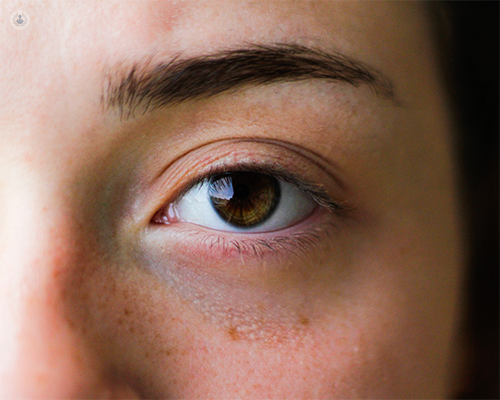Why does my child have a coloboma?
Escrito por:Some children are born with a key-hole shaped rather than a round pupil – the technical term for this is coloboma. Usually, the elongated part of the pupil is at the bottom part of the iris, towards the nose. A coloboma is the result of an incomplete development of that particular part of the eye. Renowned consultant ophthalmologist Dr Annegret Dahlmann-Noor details information for parents and carers.

What causes coloboma?
In the first weeks of pregnancy, the eye initially forms as separate parts – parts of the future brain develop areas which will become the retina, the layer of specialised cells at the back of the eye which change light into electrical signals. The surface layers of the early embryo form the tissues which will become the lens, the front of the eye, and the eyelids.
The part of the eye that develops from the brain starts off as a “vesicle”, like a droplet that is connected to the brain. This droplet then flattens into a tissue shaped like a cup, or a saucer. The folded-over parts of the retina, the underlying layer (choroid), and the iris (blue/brown part at the front of the eye) fuse in a circle towards the bottom of the eyeball – and if they do not fuse completely, then the gap results in a coloboma.
What are the problems that a coloboma can cause?
Most of the time, only the iris has not fused completely, and the result is a keyhole-shaped pupil. This does not cause the child any discomfort, and does not usually cause eye problems. The vision is also usually normal, but it is worth visiting an eye care professional to check and monitor visual development. If the coloboma is large, the pupil may be bigger than normal and let more light into the eye. This can make the child sensitive to light, and sunglasses or glasses with tinted lenses can help. All children should also have regular tests for glasses, to detect any issues such as short- or long-sightedness or astigmatism early.
In some children with coloboma, other tissues inside the eye may also not have developed completely: the retina, the underlying layer (choroid) and sometimes even the optic nerve. These areas tend to be at the bottom of the eyeball, towards the nose, like the iris coloboma. If part of the retina has not developed, the child will be missing the corresponding part of their peripheral vision – usually towards the top of the visual field. This is not something children will tell their parent/carer about, because they have never known their vision to be any different. However, if the “missing” part of the retina or optic nerve is very large, then the central vision may be affected. Parents may notice that their child may not be able to see well, may not be as interested in faces or toys as they would expect them to be, and/or that their eyes are moving around a lot.
Can there be other eye or health problems with coloboma?
In most children, the coloboma is the only health problem, but in some, there can be other problems with the eyes or with other parts of the brain and body. Abnormally small eyes (microphthalmia) and cloudy lenses (cataract) are rare conditions which can co-exist with coloboma. An eye doctor specialising in children’s eye conditions will carry out a full examination of the eyes to see whether there are any problems in addition to the iris coloboma which is easy to spot. The eye assessment includes measuring your child’s level of vision, a test for glasses, and checking the health of the eye. Sometimes additional tests are required, such as an ultrasound scan and/or visual electrodiagnostic tests, if the lens is cloudy.
If there are any problems affecting other parts of the body, these are usually detected as soon as the child is born, and the paediatric team will continue to look after your child. Sometimes, if there are no other obvious issues, the eye specialist will refer your child to a paediatrician to make sure that there are no subtle changes which may not have been noticed at birth.
When should a specialist be seen?
Your eye specialist or paediatrician may also refer your family to a genetics service. Whilst most children are the only family member to have a coloboma, they can pass this change on to their children. It is also possible that more than one child in the family is born with coloboma, and genetic testing may give parents an explanation and information about the risk for future children.
If you think your child may have an eye condition or you are experiencing problems with your eyes, you can go to Dr Dahlmann-Noor's profile and book a consultation.


